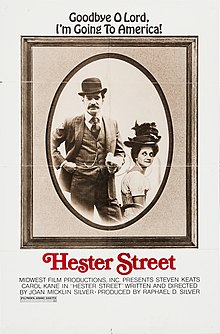Hester Street (film)
| Hester Street | |
|---|---|
 Theatrical release poster | |
| Directed by | Joan Micklin Silver |
| Screenplay by | Joan Micklin Silver |
| Based on | Yekl: A Tale of the New York Ghetto by Abraham Cahan |
| Produced by | Raphael D. Silver |
| Starring | |
| Cinematography | Kenneth Van Sickle |
| Edited by | Katherine Wenning |
| Music by | Herbert L. Clarke, William Bolcom |
Production company | Midwest Films |
| Distributed by | Midwest Films |
Release date |
|
Running time | 90 minutes |
| Country | United States |
| Languages |
|
Hester Street is a 1975 romantic film based on Abraham Cahan's 1896 novella Yekl: A Tale of the New York Ghetto, and was adapted and directed by Joan Micklin Silver.[1] In 2011, Hester Street was added to the National Film Registry of the Library of Congress.[2]
The film stars Steven Keats and Carol Kane. Kane was nominated for the Academy Award for Best Actress.
Plot[]
Hester Street tells the story of Jewish immigrants who come to the Lower East Side of New York City in 1896 from Eastern Europe, and who live on Hester Street in Manhattan. When Yankle first comes to the U.S., he quickly assimilates into American culture, and becomes Jake. He also begins to have an affair with Mamie, a dancer. His wife, Gitl, who arrives later with their son, Yossele, has difficulty assimilating. Tension arises in their marriage as Jake continually upbraids and abuses Gitl. Additionally, Jake continues to see Mamie, which Gitl later discovers through Mrs. Kavarsky, a neighbor. Jake and Gitl ultimately divorce, whereby Gitl takes all of Mamie's money and marries Bernstein, a faithful traditionalist. By the end of the film, she is sartorially and lingually assimilated — walking down the street with Bernstein and Yossele (now known as Joey), speaking English, and showing her hair. But she is now liberated from Jake, who in turn has married Mamie.
The film is noteworthy for its detailed reconstruction of Jewish immigrant life in New York at the turn of the century – much of the dialogue is delivered in Yiddish with English subtitles – and was part of the wave of films released in the late 1960s and through the 1970s which began explicitly to deal with the complexities of American Jewish identity. In addition, Carol Kane's lead character posed a still-provocative synthesis as she discovers her own self-assertion on behalf of her right to maintain a traditional identity in an aggressively modern setting.
Cast[]
- Steven Keats as Jake
- Carol Kane as Gitl
- Mel Howard as Bernstein
- Dorrie Kavanaugh as Mamie
- Doris Roberts as Mrs. Kavarsky
- Lauren Friedman as Fanny
Reception[]
Variety was positive, stating that Hester Street "deftly delves into Jewish emigration" and that Silver "displays a sure hand for her first pic".[3] Turned down by multiple Hollywood studios for being "too ethnic," Hester Street went on to earn $5 million at the box office against a budget of only $370,000.[4]
Awards[]
Hester Street was nominated for the Academy Award for Best Actress – Carol Kane. In 2011, this film was deemed "culturally, historically, or aesthetically significant" by the United States Library of Congress, and selected for the National Film Registry.[5] In making its selection, the Registry state that Hester Street was "a portrait of Eastern European Jewish life in America that historians have praised for its accuracy of detail and sensitivity to the challenges immigrants faced during their acculturation process".[5]
References[]
- ^ "Hester Street". Turner Classic Movies. Retrieved April 19, 2016.
- ^ "Complete National Film Registry Listing | Film Registry | National Film Preservation Board | Programs at the Library of Congress | Library of Congress". Library of Congress, Washington, D.C. 20540 USA. Retrieved 2020-04-30.
- ^ "Review: 'Hester Street'". Variety. December 31, 1974. Retrieved February 11, 2017.
- ^ Bruce Haring (January 1, 2021). "Joan Micklin Silver Dies". Deadline. Retrieved January 2, 2021.
- ^ Jump up to: a b "2011 National Film Registry More Than a Box of Chocolates". Library of Congress. December 28, 2011. Retrieved December 28, 2011.
External links[]
- Hester Street essay by Eric A. Goldman on the National Film Registry website [1]
- Hester Street on Turner Classic Movies
- Hester Street at IMDb
- Watch Hester Street
- 1975 films
- 1975 directorial debut films
- 1975 drama films
- American black-and-white films
- American films
- English-language films
- Films about Jews and Judaism
- Films based on American novels
- Films directed by Joan Micklin Silver
- Films set in New York City
- Films set in the 1890s
- United States National Film Registry films
- Yiddish-language films